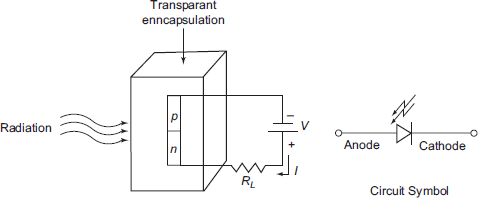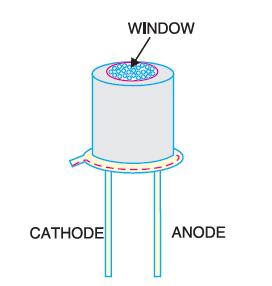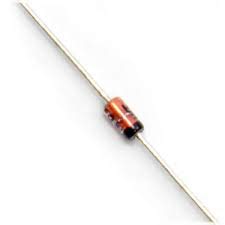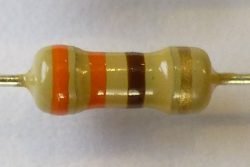Table of Contents
PhotoDiode
Definition: A photodiode is a P-N junction that is operated under reverse bias and when exposed to light energy, the normal reverse current of the diode varies due to the generation hole-electron pairs in the junction region.
A photodiode is a specialty diode that detects light. In other types of diodes, the P-N junction area is usually shielded from light, so light energy doesn’t interfere with the function of the diode. A photodiode is designed to register light energy and so is not shielded from light.
Whenever you see the prefix photo-, you know it is about light. A few other prefixes to keep in mind when working with electronics vocabulary: hydro- relates to water; chrono- relates to time; chromo- relates to color, and tele- relates to a distance.
Photodiodes use a PIN structure (P-type semiconductor, I-type semiconductor, N-type semiconductor) or a NIP structure (N-type semiconductor, I-type semiconductor, P-type semiconductor). This forms a wider band so the diode can detect longer light wavelengths.
An I-type semiconductor is an intrinsic semiconductor, meaning that it is a material that has excited electrons even when no dopant is introduced; instead, the electrons are excited through thermal excitation or by crystalline defect when a current is applied.
Photodiodes have many electronics applications, from optical storage and retrieval to telecommunications and photography.
Photodiode and its circuit symbol
A photodiode is a P-N junction that is operated under reverse bias and when exposed to light energy, the normal reverse current of the diode varies due to the generation hole-electron pairs in the junction region. As mentioned earlier, radiation affects the minority carriers more than the majority carriers. So, in reverse bias, the change in current is felt much more than in forward bias. Photoconductors provide a change in conductivity proportional to the exposed optical energy. In present-day electronics, optical signals are also having a wider range of applications with photodiodes as electronic devices.
A photodiode is an optoelectronic device that produces an electronic output (current) for light energy input. Its applications span a wide range including sound recording on films, street light control, bar code detection on consumer products, CD reading in computer applications, fiber optic communications, and optoisolators, which reduce coupling between input and output and a host of other applications.
It is an established fact that the reverse saturation current of a conventional diode gets doubled for every 10°C rise in temperature. But temperature rise is caused by heat, that is, thermal radiation, which is electromagnetic in nature. The difference between heat and light is only of the range of frequencies of radiation.
So, it is natural to expect the reverse saturation current to change when a diode junction is exposed to visible or invisible radiation. For instance, infrared energy in the lower invisible frequency domain and the ultraviolet radiation is in the upper invisible region of the EM wave spectrum for photoelectric devices.
PhotoDiode package
The figure shows a typical photo-diode package. It consists of a PN
junction mounted on an insulated substrate and sealed inside a metal case. A glass window is mounted on top of the case to allow light to enter and strike the PN junction. The two leads extending from the case are labeled anode and cathode. The cathode is typically identified by a tab extending from the side of the case.
A P-N junction is housed in a clear plastic housing with inbuilt lens across an open window through which light can be focused onto the center of the junction. If the junction is exposed to radiation, minority carrier increase occurs in both the regions about the junction. But for the window, the other areas are coated with non-transparent paint.
Working Principle of PhotoDiode
The P-N diode has depletion region width W depending on the doping on the N and P regions. When the diode junction is reverse biased, the depletion width increases and a normal reverse saturation current I0 flows. If the junction is irradiated uniformly or illuminated by photons with energy hf greater than EG, new covalent bonds break forming hole-electron pairs, thus increasing the reverse saturation current by a magnitude IL. Larger the quantum of radiation, larger changes in reverse saturation current occur. The change in reverse saturation current is almost directly proportional to the incident radiation. The current that flows in the circuit in the absence of radiation is called the dark current.
The usual dark current is of the order of 10 microamps. Smaller the dark current better is the performance of the device. The signal current will be the difference between the dark current IL and the current under the incidence of radiation. So, smaller the dark current, larger is the signal current from the device.
PhotoDiode Characteristics
The device characteristics comprise the variation of current with reverse bias voltage for different illumination strengths that is lumens. Thus, a set of characteristics can be obtained between voltage and current one each for a specific light flux in lumens as shown in the figure below.
The expression for the current in a photodiode can be represented as follows:
I_{T}=I_{L}+I_{0}\left [ 1-e^{\frac{V_{B}}{\eta V_{T}}} \right ]where IT represents the total current, IL is the current due to incident illumination (optical generation of hole-electron pairs); I0 is the reverse saturation current of the diode; VB is the reverse bias voltage. In the absence of illumination, IT can be seen to be just the reverse saturation current I0 for large values of reverse bias VB or simply the dark current which is of the order of 10 microamperes. The incident illumination produces excess electron-hole pairs proportional to illumination as explained earlier.

In the absence of radiation or illumination is cut-off or zero illumination, the voltage across RL is almost negligible if the dark current is small (dark current is of the order of 10 microamps). When light falls on the window of the photodiode, the current increases in proportion to the incident light energy (when hf is greater than EG) and a voltage is developed across RL, which constitutes the signal. Optical signals can thus generate a proportionate voltage output and a photodiode can serve as an optoelectronic converter. For instance, 0 sec and 1 sec (in the form of no light and light) can produce lower and higher voltages corresponding to binary digits.
Advantages of Photodiode
- It has a very less response time when exposed to light.
- It’s operational speed is very high.
- Photodiode provides a linear response.
- It’s cost is very low.
Disadvantages of Photodiode
- Photodiode shows a poor temperature stability.
- Current amplification is required, when light intensity is low.





